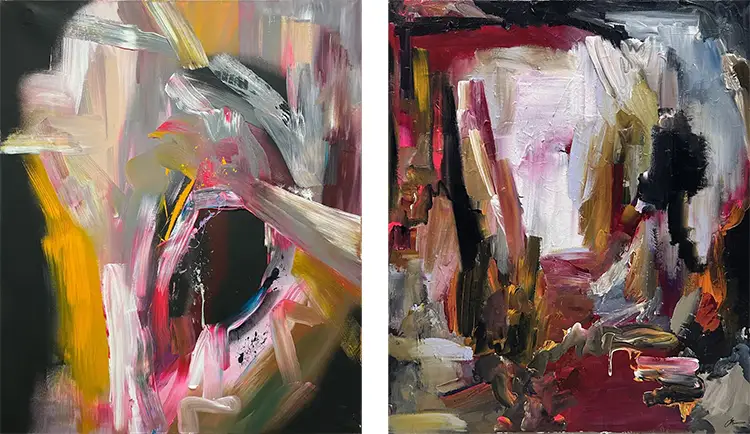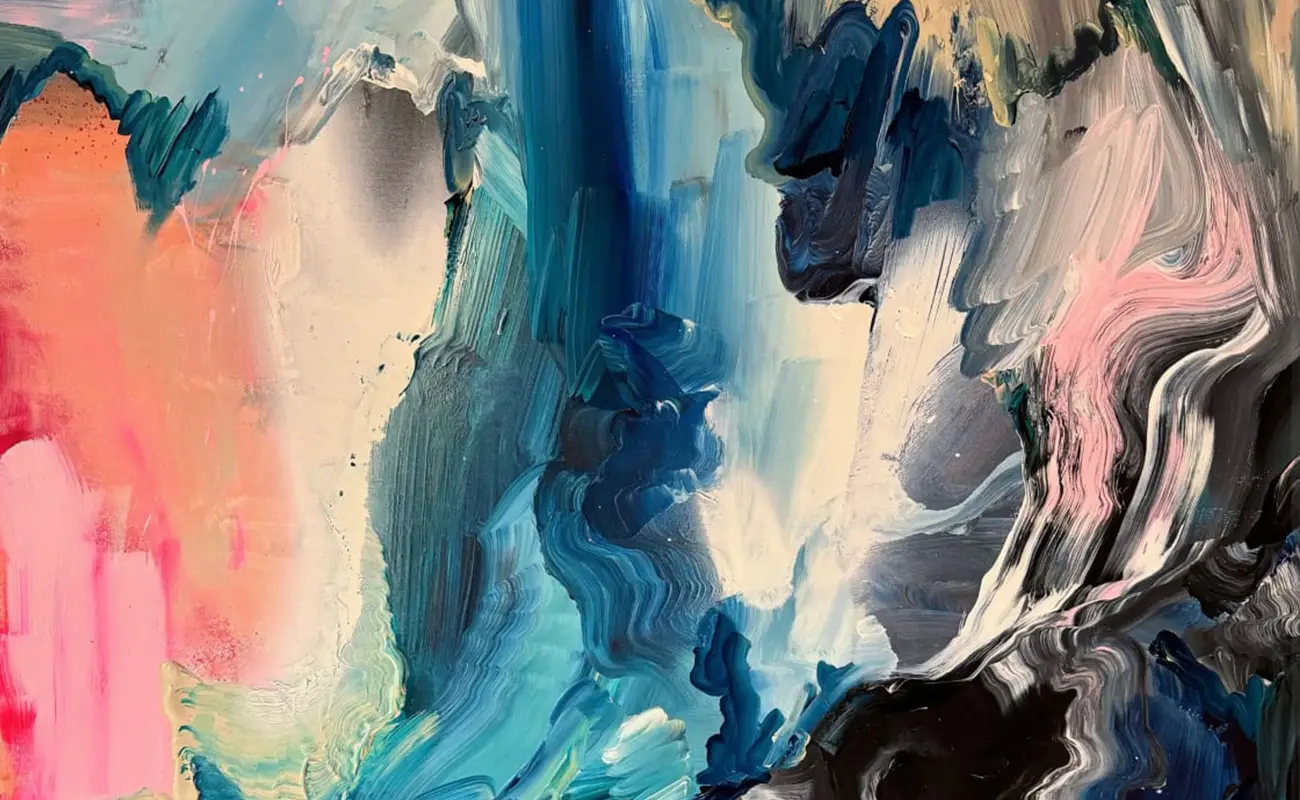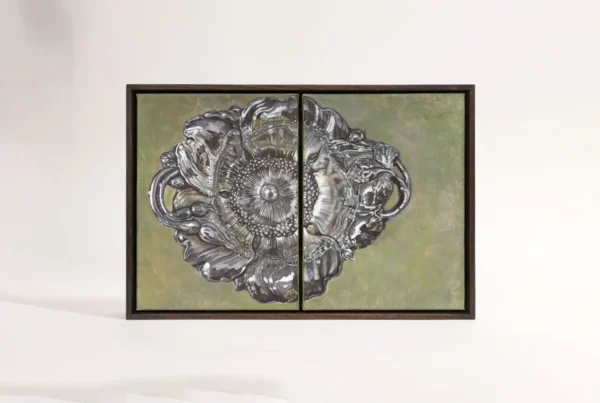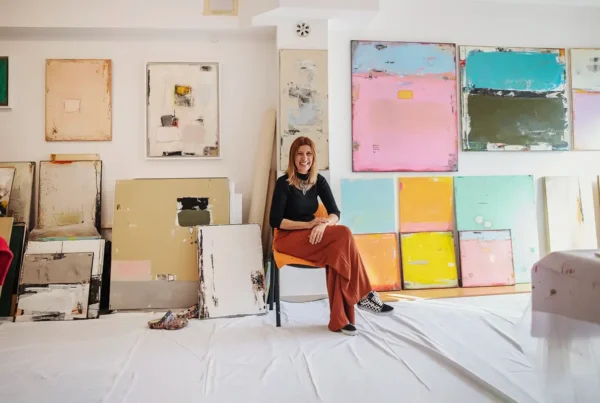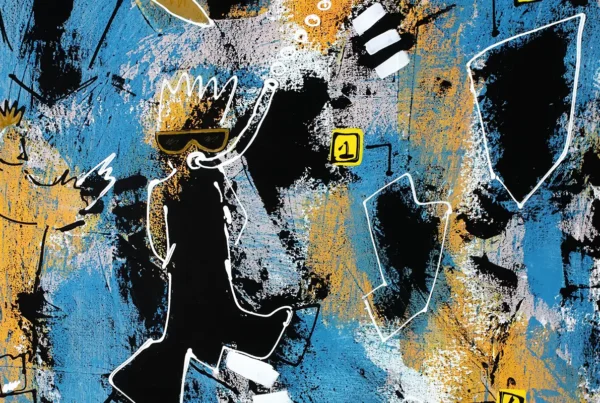The Colour of Sound, the Shape of Emotion
Jake-Andrew’s work challenges how we define visual art by introducing the unseen elements that live beneath its surface. A British multidisciplinary artist and experimental musician, he builds his entire practice around synaesthesia—a neurological condition that allows him to perceive sound as colour, texture, and form. This rare sensory crossover does more than influence his aesthetic; it becomes the driving force behind a body of work that vibrates with emotion, movement, and an underlying musicality. Positioned between gestural abstraction, immersive installation, and digital art, his creations are not static images but living experiences, where the boundaries between hearing and seeing dissolve. For Jake-Andrew, painting is not a process of representing the world, but of translating deeply internal states into visual compositions that pulse with sonic and emotional frequency.
His creative journey began on a very different stage—touring the world as a musician. Painting initially emerged as an instinctive response to the sounds around him, a way to “write music” in colour rather than notes. That process soon grew into something more urgent, more expansive. In a defining moment of personal and artistic clarity, he stepped away from his musical career mid-tour, enrolling first in a foundation course and later pursuing both undergraduate and postgraduate degrees in Fine Art. During his MA, he began to question the rigidity of the painted surface. Could a painting reflect the mutable, ever-shifting nature of human feeling? That question became a compass guiding his future work, setting in motion a decade of artistic investigation into how sound and sentiment might be visually encoded.
Jake-Andrew’s paintings often function as sensory maps, charting the inner terrain of mood and memory through striking chromatic interplay and expressive gesture. His approach to abstraction is uniquely anchored in the emotional charge of music and the complex spectrum of human experience. At the core of his work is an effort to give form to what defies verbal explanation. He describes this effort as “saying the things we don’t know how to vocalise,” constructing a visual language from the echoes of emotion and the resonance of sound. Each piece invites viewers into a shared moment of reflection, where subjective perception becomes the bridge between artist and audience.
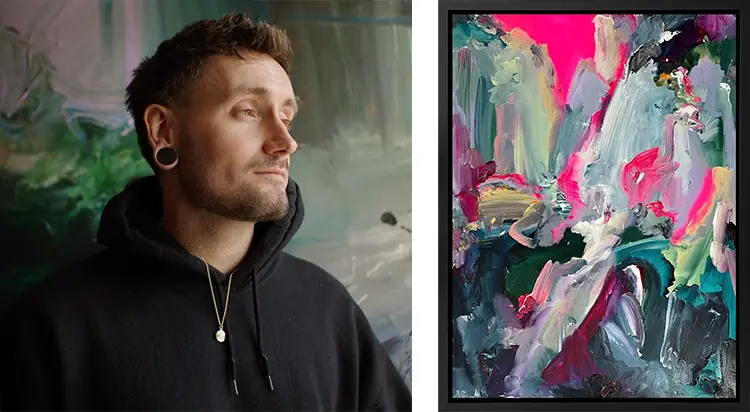
Jake-Andrew: Between Instinct and Interpretation
At first glance, Jake-Andrew’s paintings confront the viewer with their raw intensity, vivid colour schemes, and dramatic gestural energy. But beyond the visual spectacle lies a deeper tension—a dialogue between chaos and control, improvisation and structure. His work draws heavily from his musical foundation, with compositions that resemble choreographed performances frozen in time. Colours often clash or collide, then soften into quiet harmonies, much like notes in a score. Heavy textures emerge from layered paint applications, scraped back or built up to suggest depth, movement, and tactile resonance. The work does not merely depict feeling; it captures the exact moment when emotion is transformed into action, where brushstrokes echo the rhythm of a thought or a sound.
The artist’s synaesthesia operates not just as a source of inspiration but as an integrated method of creation. Music becomes material. Jake-Andrew experiences auditory input as a flood of visual data—shapes, patterns, gradients, and movement—each with its own emotional implication. These sensations are not imagined but involuntary, forming a visual-emotional syntax that guides his every mark. His artistic process is physical and immersive, involving an almost performative interaction with the surface. In many ways, the canvas becomes a stage, and the act of painting turns into a concert of colour and sensation. This convergence of sensory inputs produces work that resists categorisation, standing at the intersection of action painting, performance, and experimental digital composition.
One of the most significant milestones in Jake-Andrew’s practice came with “A Study in E-Major,” an ambitious, multisensory exhibition staged at TODA Dubai in 2023. The installation fused analog and digital techniques—combining painting, projected visuals, and live audio performance into an all-encompassing environment. Here, his vision reached a new level of spatial complexity, allowing viewers to step inside his synesthetic experience. Rather than passively viewing artworks, the audience became immersed in a spatial narrative of sound and sensation. This project encapsulated his long-standing inquiry into whether a painting could evolve, breathe, and shift like the human emotions it seeks to express. It also reinforced his commitment to immersive, emotionally honest art that encourages audiences to consider their own relationships with sound, memory, and perception.
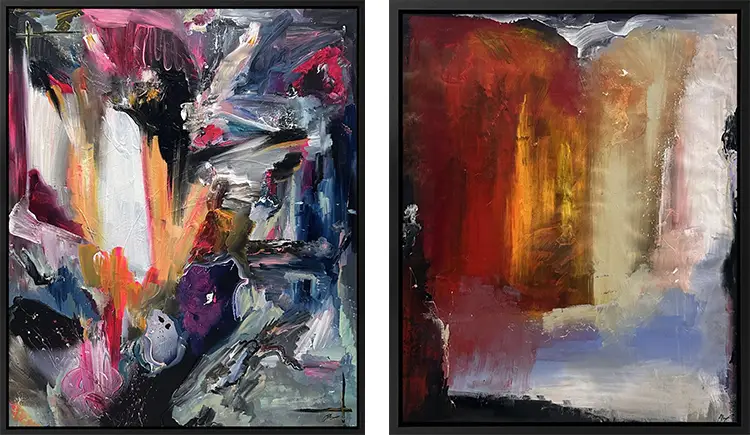
Immersion as Interpretation
In addition to his solo work, Jake-Andrew has carved out a space at the crossroads of fine art, commercial collaboration, and digital media. His ability to seamlessly translate internal perception into visual and spatial form has led to creative partnerships with brands such as Adidas, Braun Audio, and Glenfiddich. These projects are far from conventional endorsements; they are experimental ventures that merge branding with artistic storytelling. One standout collaboration was “The Taste In Colour Experiment” with Glenfiddich, in which flavour and sensation were reinterpreted through colour and motion. Similarly, the Braun Audio and Tokio Myers “LE Series” involved a multimedia performance exploring the fusion of auditory and visual experience. These projects reflect his capacity to stretch the language of abstraction beyond the gallery setting, embedding it into contemporary culture in unexpected ways.
His collaborations also extend into digital and NFT spaces, where he has been featured at platforms such as TIMEpieces and LIFE Magazine’s showcases during NFT NYC. Working with artists like Parin Heidari and collectives like ANTONYM, he has contributed to “phygital” pieces—works that combine physical presence with digital execution. These experimental efforts point to his larger interest in how art can remain dynamic in an increasingly hybrid world. By embracing technology while staying rooted in a tactile, gestural painting practice, Jake-Andrew offers a rare synthesis of analog emotion and digital possibility. He continues to explore how digital formats can preserve, or even enhance, the sensory richness of his synaesthetic experience.
What links all of Jake-Andrew’s work—whether in solo exhibitions, brand collaborations, or NFT drops—is an unflinching dedication to emotional accessibility. Despite the complexity of his method and the abstraction of his forms, the work remains grounded in human feeling. His paintings and installations speak to the universal desire to understand ourselves through our senses, to decode emotion through rhythm, texture, and colour. By offering the audience immersive entry points—whether through projected environments, live performances, or interactive digital platforms—Jake-Andrew invites not just observation but participation. His practice becomes a shared act of reflection, a gesture of empathy in pigment and sound.
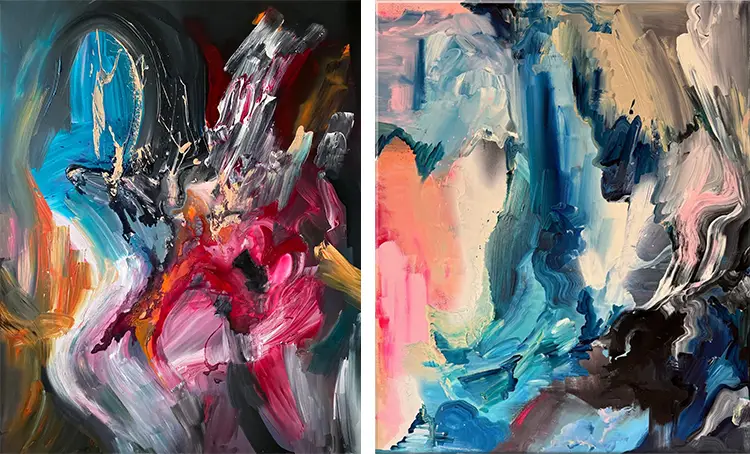
Jake-Andrew: Painting as Perceptual Performance
Jake-Andrew’s artistic philosophy centres on the idea that painting can be both an expressive performance and a sensory translation. His process does not stop at the canvas edge. Instead, it spills into projection, installation, and sound, constantly adapting to new environments and technologies. Working between Norwich and London, he transforms traditional concepts of painting by pushing them into physical space, inviting audiences to walk through, listen to, and physically experience the works. He frequently creates projected installations that blur the line between painting and performance, using motion, colour, and sound to draw viewers into heightened states of sensory awareness. These environments are not passive showcases; they are immersive invitations to reconsider how we perceive both art and emotion.
The documentary “A Perceptual Phenomenon” offers a deeper glimpse into the neurodivergent lens that shapes Jake-Andrew’s creative process. It captures the essence of his experience living with synaesthesia, showing how music, memory, and visual language merge within him. This exploration is central to his mission: to bridge internal and external worlds through sensory engagement. While his collectors often remain discreet, the value placed on his work reflects a growing appreciation for the emotional intelligence embedded in his art. Viewers are not expected to “understand” his pieces in the traditional sense, but rather to feel them, to interact with them as living, evolving energies.
Looking forward, Jake-Andrew continues to develop projects that expand the vocabulary of painting into the digital and immersive spheres. His upcoming work investigates how physical and emotional stimuli can be captured and translated into art that exists beyond conventional formats—blending light, sound, and space into integrated environments. At its heart, his practice is not about spectacle or abstraction for its own sake, but about connection: between self and other, between colour and sound, between chaos and clarity. Jake-Andrew’s work does not just reflect the world—it reorients the senses, reminding us that perception is never singular, and that within each of us exists a deeply personal universe of feeling, waiting to be expressed.
